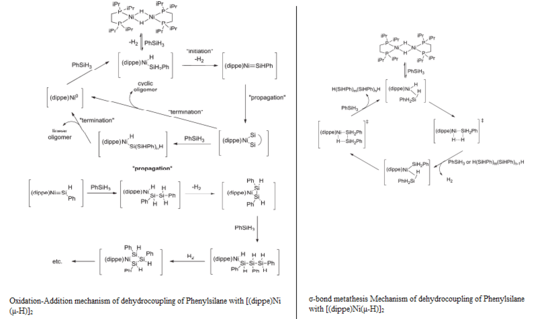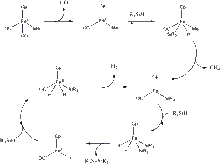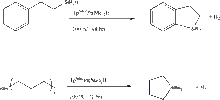Dehydrogenative coupling of silanes
The dehydrogenative coupling of silanes is a reaction type for the formation of Si-Si bonds. Although never commercialized, the reaction has been demonstrated for the synthesis of certain disilanes as well as polysilanes. These reactions generally require catalysts.

Metallocene-based catalysts
Titanocene and related their complexes are typical catalysts. A typical reaction involves phenylsilane:[1][2]
- n PhSiH3 → [PhSiH]n + n H2
Para- and meta-substituted phenylsilanes polymerize readily but ortho-substituted polymers were failed to form. Polymers white/colorless, tacky and soluble in organic solvents. Crosslinking was not observed.[3]
Using Cp2Ti(OPh)2 as a catalyst, the dehydrogenative coupling of phenylsilane in the presence of vinyltriethoxysilane produces a polysilane terminated with a triethoxysilylvinyl group.[4]
Other catalysts
Nickel-based catalysts
The nickel(I) complex [(dippe)Ni(µ-H)]2 promotes the dehydrogenative coupling of some silanes.[5]

Oxide-based catalysts
While catalysts for dehydrogenative coupling reactions generally tend to be transition metal complexes, magnesium oxide and calcium oxide for the conversion of phenylsilane. Being a heterogeneous process, the products are easily separated from the catalyst.[6]
Wilkinson's Catalyst
Dehydrogenative coupling of primary silane using Wilkinson's catalyst is slow and dependent on the removal of H2 product. This conversion proceeds by oxidative addition of the Si-H bond and elimination of dihydrogen.[7]
Borane catalysts
Tris(pentafluorophenyl)borane (B(C6F5)3)) is another catalyst for the dehydrogenative coupling of tertiary silanes. This system has the useful characteristic of being selective for Si-H bonds vs Si-Si bonds, leading to fewer branches and more linear polymers. This catalyst is particularly useful in reactions involving thiols and tertiary silanes or disilanes.[8]
Related reactions of hydrosilanes
Dehydrodimerization of tertiary silanes
Due to steric factors, dehydrogenative coupling of tertiary silanes is slow. Disilane formation has been demonstrated in the presence of CpFe(CO)2CH3 combined with UV-irradiation. The mechanism is proposed to involve dissociation of CO ligand, oxidative addition of the Si-H center, followed by reductive elimination of methane. From there, the disilane R3Si-SiR3 is reductively eliminated from the complex.[9]

In addition, this same iron catalyst can be used to build polymers with a Si-R-Si backbone. When R = phenylene, NH, or (C5H4)Fe(C5H4), this reaction works particularly well, and yields of over 95% are obtained.
Cross-coupling
As well as being coupled to each other, tertiary silanes can be coupled with carboxylic acids to form silyl esters. Ru3(CO)12/EtI is a good catalyst for this. This reaction applies to a wide range of silanes and acids.[10] The complex [Cu(PPh3)3Cl] can also be used to produce silyl esters.[11]
Tertiary silanes may also be dehydrogenatively coupled to aromatic rings with the use of the catalyst TpMe2Pt(Me)2H (TpMe2 = hydrido tris(3,5-dimethylpyrazolyl)borate). For example, this platinum catalyst can be used to react triethyl silane with benzene to produce phenyltriethylsilane, with the elimination of hydrogen gas. This is a terrific catalyst because it eliminates the need for a hydrogen acceptor, something which is normally required for the silation of a C-H bond. This reaction may also be done intramolecularly to produce five- or six-membered silicon-containing rings fused to a phenyl ring. In addition, tributylsilane can be converted into the corresponding cyclic organosilane via the same process. A drawback to this catalyst, however, is that it requires rather harsh reaction conditions (typically 200 °C for 24 hours for the intermolecular reaction, 48 – 72 hours for the intramolecular ones). It is also not particularly regioselective, so starting materials containing substituted benzene would result in a mixture of products.[12]

Polymer characterization
1H and 29Si NMR spectroscopy can sometimes be used to help identify and characterize products from these reactions.[1]
Infrared spectroscopy may also be useful as it can indicate whether or not the product is a tertiary silane. The stretch for Si-H is seen at around 2100 and 910 cm−1. In the case of tertiary silanes however, the peak at 910 cm−1 is not seen. The shift or change in these peaks will be affected by the size of the polymer.[1]
References
- Aitken, C.; Harrod, J. F.; Gill, U. S. (1987). "Structural studies of oligosilanes produced by catalytic dehydrogenative coupling of primary organosilanes". Can. J. Chem. 65: 1804–1809. doi:10.1139/v87-303.
- Corey, J.Y.; Zhu, X.H.; Bedard, T.C.; Lange, L.D. (1991). "Catalytic Dehydrogenative Coupling of Secondary Silanes with Cp2MCl2". Organometallics. 10 (4): 924. doi:10.1021/om00050a024.
- Banovetz, John P.; Suzuki, Hiroshi; Waymouth, Robert M. (1993). "Dehydrogenative coupling of substituted phenylsilanes synthesis of poly[((trifluoromethyl)phenyl)silanes]". Organometallics. 12 (11): 4700–4703. doi:10.1021/om00035a070.
- Garcia, Julien; Meyer, Daniel J.M.; Guillaneux, Denis; Moreau, Joël J.E.; Wong Chi Man, Michel (July 2009). "Investigation of titanium-catalysed dehydrogenative coupling and hydrosilylation of phenylhydrogenosilanes in a one-pot process". Journal of Organometallic Chemistry. 694 (15): 2427–2433. doi:10.1016/j.jorganchem.2009.03.018.
- Smith, Erin E.; Du, Guodong; Fanwick, Phillipe E.; Abu-Omar, Mahdi M. (2010). "Dehydrocoupling of Organosilanes with a Dinuclear Nickel Hydride Catalyst and Isolation of a Nickel Silyl Complex". Organometallics. 29 (23): 6529. doi:10.1021/om100887v.
- Itoh, M.; Mitsuzuka, M.; Utsumi, T.; Iwata, K.; Inoue, K. (1994). "Dehydrogenative coupling reactions between hydrosilanes and monosubstituted alkynes catalyzed by solid bases". Journal of Organometallic Chemistry. 476: C30–C31. doi:10.1016/0022-328X(94)87091-8.
- Rosenberg, Lisa; Kobus, Danielle N. (2003). "Dehydrogenative coupling of primary alkyl silanes using Wilkinson's catalyst". Journal of Organometallic Chemistry. 685 (1–2): 107–112. doi:10.1016/S0022-328X(03)00712-5.
- Harrison, D. J.; Edwards, D. R.; McDonald, R.; Rosenberg, L. (2008). "Toward selective functionalisation of oligosilanes: borane-catalysed dehydrogenative coupling of silanes with thiols". Dalton Trans. 26: 3401–3411. doi:10.1039/b806270f.
- Itazaki, M.; Kensuke, U.; Nakazawa, H. (2009). "Iron-calalyzed dehydrogenative coupling of tertiary silanes". Angewandte Chemie. 48: 3313–3316. doi:10.1002/anie.200805112.
- Liu, G.; Zhao, H. (2008). "Ru-catalyzed dehydrogenative coupling of carboxylic acids and silanes - a new method for the preparation of silyl esters". Beilstein Journal of Organic Chemistry. 4 (27). doi:10.3762/bjoc.4.27. PMC 2511026.
- Liu, G. -B.; Zhao, H. -Y.; Thiemann, T. (2007). "Two New Catalysts for the Dehydrogenative Coupling Reaction of Carboxylic Acids with Silanes - Convenient Methods for an Atom-Economical Preparation of Silyl Esters". Synthetic Communications. 37: 2717–2727. doi:10.1080/00397910701465669.
- Tsukada, N.; Hartwig, J. F. (2005). "Intermolecular and intramolecular, platinum-catalyzed, acceptorless dehydrogenative coupling of hydrosilanes with aryl and aliphatic methyl C-H bonds". Journal of the American Chemical Society (127): 5022–5023. doi:10.1021/ja050612p.
- Sakomto, Kenkichi; Yoshida, Masaru; Sakurai, Hideki (1990). "Highly ordered high-molecular weight alternating polysilylene copolymer prepared by anionic polymerization of masked disilene". Macromolecules. 23 (20): 4494–4496. doi:10.1021/ma00222a031.
- Shono, T.; Ishifune, S.; Nishida, R. (1997). "Electroreductive synthesis of some functionalized polysilanes and related polymers". Tetrahedron Letters. 38 (36): 4607–4610. doi:10.1016/S0040-4039(97)00987-8.